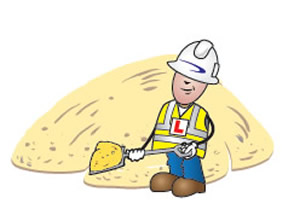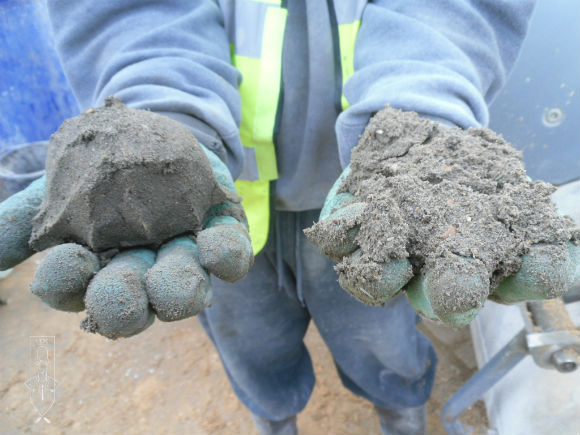
A Practical Guide to Screed Testing: What Do the Experts Say?

A Practical Guide to Screed Testing: What Do the Experts Say?
Screed - The Components Needed
A Quick Guide to a Good Screed

From the type of cement, to the grade of aggregate and the method of storage of screed material – there are several details that determine the final quality of a screed.
Though mix proportions vary for depending on the intended use of the screed, the normal range specified for cement-sand levelling screeds is a mix proportion of 1:4.5 – Portland cement: sand/aggregate. Listed below are the components/factors that need to be considered:
Cement
The British Standards provides guidance regarding the types of cement that are best suited for different kinds of screeds. It is important to choose the specified cement type for best results, as variations in cement quality can affect the strength development of the screed and its susceptibility to poor curing.
For a general fine concrete screed, the recommended cement is ordinary Portland class 42.5N cement. But in cases where class 32.5N cement is used, an additional 10% should be added to the recommended mix proportion to achieve the expected results.
Aggregates
The size and shape of aggregates can have considerable impact on the performance and appearance of a screed. Make sure the aggregates do not contain unacceptably high amounts of deleterious materials such as lignite, coal or iron pyrites, as it can cause ‘pop-out’ on the screed surface.
The aggregate type specified for ordinary cement-sand levelling screed is 0-4 mm washed sharp sand.
For general fine concrete screeds a mix ratio of 1:1:3 (cement: single sized aggregate: sand) can be used, where the aggregate replaces 25% of the sand.
For heavy duty fine concrete levelling screeds, the aggregate specified is: single sized aggregates between 6mm and 10mm.
Single sized finely graded sand, fine brick-laying sands, crushed rock-fines and sea-dredged sand containing high amounts of flat shell are to be avoided.
Water
Water should be running potable water. The amount of water can be adjusted on site to suit different mix designs. The ideal quantity is described as enough water to facilitate easy pumping, trowelling and compaction of the screed-mix.
To make sure the screed consistency is right, use the simple ‘Snowball Test’, see above. Squeeze a handful of the screed-mix tightly with a gloved hand. The consistency is right if the screed holds together without dripping water. (In the picture, the left sample is good.)
Fibres
Polypropylene (PP) fibres are added to the screed mix to reinforce the screed and to reduce the incidence of cracking. The PP fibres work by deflecting micro cracking created by the stress generated during the drying of cement. However, PVA (Poly Vinyl Acetate) fibres are water sensitive, and should not be used in areas expected to be exposed to permanent dampness.
Admixtures
Admixtures, additives or cement replacements are useful in bringing down the cement/water ratios – providing faster drying and less shrinkage and curling. The common types of admixtures available are:
- Water-reducing
- Superplasticizing
- Air-entraining
- Accelerating
- Waterproofing
- Retarding
As these are proprietary materials, and vary from one manufacturer to the other, always make sure the manufacturer’s instructions are followed while using the products. It is important to understand the interaction and ensure compatibility before using two or more admixtures together.
Storage
Portland cement is a highly vulnerable item, and should be stored off the ground and kept covered – protected from damp and extreme temperature conditions.
If mixing and laying of screed are to proceed during cold weather, make sure the stored cement and aggregates are kept at temperatures above freezing. (In case the aggregates are exposed to moisture during wet weather, it is important to make adjustments in the water level used during the mixing of screed.)
Screed Protection
Levelling screeds are not designed to be used as wearing surfaces, therefore always make sure the surfaces are adequately protected against damage or wear during subsequent building operations.
During freezing weather, the surface temperature of the laid screed (not the air temperature) should be kept above 5˚C during construction and for 4-5 days after laying. Make sure freshly installed screed is covered with carefully lapped tarpaulin or plastic sheets – supported away from the surface using temporary framework.
In hot/drying weather, keep the screeded surface protected with plastic sheeting or adequate material, to protect the screed from the risks of thermal cracking.
Reference:
British Standard – Screeds, Bases and In-situ floorings, Part 1: Concrete bases and Cementitious Levelling Screeds to receive flooring – Code of Practice
CIRIA – Screeds, Flooring and Finishes – Selection, Construction and Maintenance
BRE Building Elements – Floor and Flooring






